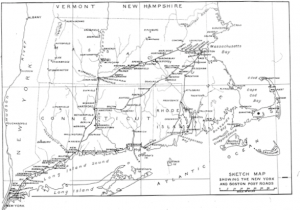By several accounts, John Oldham was a trouble-maker. He was argumentative, hot-tempered, and known to quickly fly into rages. However, his adventurous spirit led him to be take risks, including becoming the first European to travel what would later be called the Boston Post Road.
"...On Their Particular"
John Oldham arrived in the Plymouth Colony on the Anne in 1623 with his wife and stepson, “on their Particular”: that is, not sponsored by the core emigrant group and thus not required to work for the communal good of the Colony. William Bradford in his history of Plymouth Colony notes that:
Those that came on their Particular looked for greater matters than they found or could attain unto, about building great houses and such pleasant situations for them as themselves had fancied; as if they would be great men and rich all of a sudden. But they proved castles in the air. [1]
Shortly after arriving in Plymouth, John Oldham began to foment trouble among the discontented.[2] When John Lyford, a minister aligned with the Church of England but pretending to be allied with the separatists, arrived in 1624, the two Johns:
Grew very perverse, and showed a spirit of great malignancy, drawing as many into faction as they could… So as there was nothing but private meetings and whisperings amongst them.[3]
Matters came to a head in the summer of 1624 and John Oldham was expelled from Plymouth Colony.[4] He apparently went northward to Nantasket where he stayed for a few years before moving to Watertown. There he managed to burn his house down in August of 1632 “by making a fire in it when it had no Chimnye.”[5]
“Ouer land to Connectecott”
As a man of action, Oldham soon came to the notice of Governor John Winthrop. In 1633, on behalf of the Governor, John Oldham and a small party of scouts set out to travel an old Indian path from Boston to the Connecticut River:[6]
Io: Oldham & 3: with him went ouer land to Connectecott to trade, the Sachem vsed them kindly & gave them some beauer. they brought of the hempe which growes there in great abundance & is muche better than the English. he accomted it to be about 160: miles: he brought some black lead, wherof the Indians tould him there was a whole rocke. he lodged at Indian townes all <the(?)> the waye.[7]
Based on the description of finding graphite (“black lead”), Oldham probably followed a route that would become known as the Connecticut Path by 1674. Graphite was mined in Ashford in Windham County until the twentieth century. Subsequently, the Connecticut Path became the middle segment of the Boston Post Road.
Twelve years later, John Winthrop, Jr. (son of the Massachusetts governor), walked a slightly different route to the Connecticut River, after inadvertently missing the fork towards Hartford once he passed Lake Chabanakongkomun (aka Webster Lake in Webster, Massachusetts). He kept a detailed diary of his 280-mile trip with a single companion and a horse in bitterly cold weather between 11 November and 5 December 1645.[8]
From Lake Chabanakongkomun he followed the Bay Path to Springfield and then headed south to Hartford and Saybrook. He continued along the coast to present-day New London and thence to Providence and Boston. Winthrop’s route mostly outlined the other two segments of the Boston Post Road: the Upper Road (to Springfield) and the Lower Road (through Providence).
Birth of the postal service
Twenty-seven years later (1672) saw the birth of the postal service when Governor Francis Lovelace of New York met with Winthrop, now Governor of Connecticut, and agreed to establish mail delivery. The first postal rider left New York City on 22 January 1673 and arrived in Boston on 5 February. Subsequent postal riders followed the paths explored by Oldham and Winthrop. Ultimately the Boston Post Road consisted of three segments. The Worcester, Springfield, Hartford route to New Haven became known as the “Old Boston Post Road” or the Upper Road. The Middle Road left Boston and went through Dedham, Medway, Uxbridge, Douglas, Pomfret and Coventry before reaching Hartford. The Lower Road went through Dedham, Walpole, Attleboro, Providence, Warwick, Bristol, Newport, Westerly, and New London.
A gruesome end
So what became of John Oldham? He met a rather gruesome end in 1636. Governor Winthrop writes of a passing ship coming upon Oldham’s ship drifting off the coast of Block Island with “the deck was full of Indians, (14 in all).” Upon boarding the ship:
…lookinge about they fonde Io: Oldham vnder an old seyne starke naked his head clefte to the braynes, & his handes & leggs cutt as if they had been cuttinge them off, & yet warme: so they putt him into the sea.[9]
Even in death, John Oldham was a trouble-maker; his death proved to be the spark that lit the Pequot War.
Notes
[1] William Bradford, Of Plymouth Plantation 1620-1647, ed. by Samuel Eliot Morison (New York: Alfred Knopf, 1952), 127.
[2] Ibid.
[3] Ibid, 149.
[4] Ibid, 157.
[5] Richard S. Dunn, James Savage, and Laetitia Yeandle, eds., The Journal of John Winthrop 1630-1649 (Cambridge, Mass: Belknap Press, 1996), 79.
[6] Eric Jaffe, The King’s Best Highway (New York: Scribner, 2010), 4.
[7] Ibid, 97.
[8] Harral Ayres, The Great Trail of New England (Boston: Meador Publishing Company, 1940), 364–93.
[9] Dunn et al., The Journal of John Winthrop, 180.
Share this:

About Ann Lawthers
Ann G. Lawthers assists our library patrons in enhancing their research skills and in bringing alive their family histories. She is a graduate of Wellesley College, the Harvard School of Public Health and has completed the Boston University Certificate in Genealogical Research program. She has conducted genealogical projects as an independent researcher. Ann is familiar with resources for Massachusetts, Vermont, Pennsylvania, Maryland, New Jersey; and has research experience with Quebec and the Canadian Atlantic Provinces, Ireland and Germany.View all posts by Ann Lawthers →
